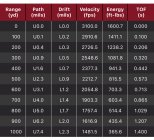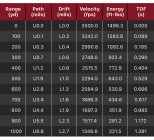If your gonna bring in wind to thr argument then you might as well GO 6BRA.
The 20 BRA is a laser will wind effect it more that bigger bullets sure it will are you good enough to shoot the difference?
Theres a reason people who shoot for pure accuracy either go Custom, Berger and a few Sierra bullets
Academically, you can see above which one is better. In practicality, the effectis in the wind are more impactful out in the world. The use case, as in what you're trying to accomplish with the bullet on the other end should be the primary consideration.
When making cartridge choices, I find it is best to consider all elements of performance and weigh them against the intended use. Real world experience goes a long way there to helping color in the blank spaces and properly allow the end user to set their expectations correctly before spending the money.
Most shooters I've had on the firing line here during various training events could definitely shoot the difference between 2 tenths of a mil. If you can't produce shots inside a tenth, and call wind to 1mph minimum, then a prairie dog at 600yds becomes a very low probability shot.
600yds at a 10mph 9:00 wind with the above 55berger at 3500, a -1/+1 mph wind (so 9mph to 11mph) will put you at 2 tenths of a mil wide mechanical dispersion. That's roughly 4" wide at 600. Depending on the orientation of the pdog, that's barely on the animal at the edges of the call, provided all else in the shot is executed flawlessly.
Add in two tenths of a mil of aerodynamic jump if the wind goes from 1:00 to 11:00, and you better have that firing solution dead on if you expect a hit.
The fact is if you run the numbers on the above scenario, the .20, .22, and 6 BRA are all running the same two tenths of a mil dispersion in a 2mph delta at 600yds. So, wind is wind, and the velocity you pick up with the smaller is negated by the ballistic coefficient loss.
The only practical way to solve the problem of wind is to move up in cartridge size. Higher BC bullets travelling at equal velocities, but even then it can be a moot point, as you need to go VERY big in order for it to matter. In the above scenario, I need to go to something like my 7 Norma Mag Improved pushing a 195 EOL at 3100fps before I see the dispersion in the wind drop to 1 tenth of a mil. Even my 6 PRC Primal pushing a 110 ATIP at 3300fps is still two tenths of a mil wide. The wind really sucks, and I fantasize about shooting pdogs on the moon.

However, and this is the big caveat... We rarely see a 2mph delta in the wind in the windy regions of this country. 6-10mph is much more frequent delta between the peak and valley. The average person lacks the wind reading ability to perform the above example. So what we see is that a shooter will typically have significantly more hits with a 22cal than 20, and this trend will continue all the way up until cartridge size and recoil presents a rifle driving/handling problem that the user isn't skilled enough to overcome. At a point, they'll perform better with lesser cartridges, because they can't drive the heavier recoil properly.
There's no wrong answer when it comes to BRA's. They are all fun and they are all good. Some better than others at certain jobs. As you can see above from the provided drop data... the .22BRA hangs right with the .20BRA. What it lacks in speed, it picks up in BC. The same is true of the 6mm. I've taken a lot of shooters out to the pdog towns over the years. They hands down gravitate toward the 22BRA. More hits, just more hits on average, if the shooting is past 300yds.
What you're hitting, is the only real question. If its a pdog, target, or coyote, any will do. Bigger jobs need more bullet if you expect success.
-----------
Follow on Instagram
Subscribe on YouTube
Amazon Affiliate














